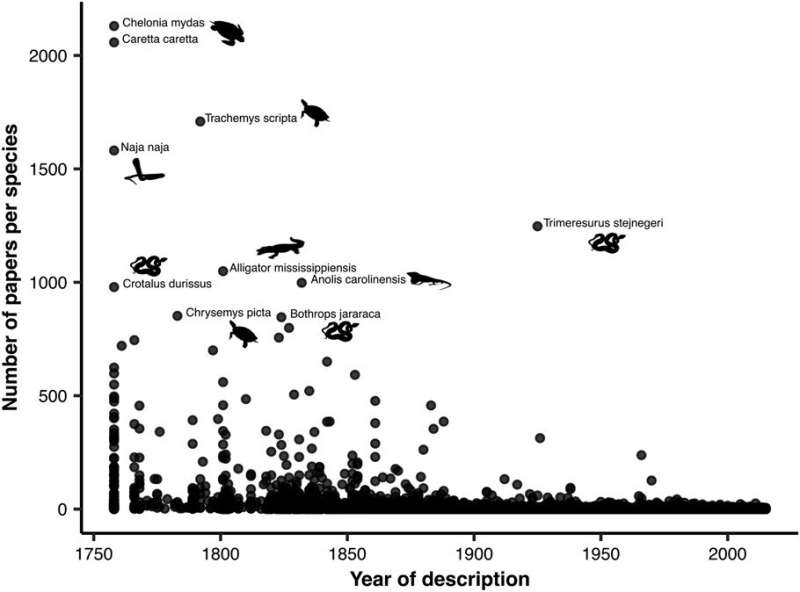This article has been reviewed according to Science X's editorial process and policies. Editors have highlighted the following attributes while ensuring the content's credibility:
fact-checked
peer-reviewed publication
trusted source
proofread
Research on reptiles is strongly influenced by access to specimens, finds review

In an article published in the journal Ecography, a group of Brazilian researchers reports the results of a review of the scientific literature on reptiles published between 1960 and 2021, considering the more than 11,000 species described since the eighteenth century.
According to the authors, who are affiliated with the Federal University of Goiás (UFG) and the State University of Campinas (UNICAMP), 15% of the articles published in the period discussed ten species (four turtles, four snakes, a lizard and a crocodile). Fewer than ten articles were published on 90.5% of all species, and none at all were published on 38.2%.
The reasons some reptile species are more studied than others, they suggest, have to do with size, type of habitat, danger of extinction, proximity to research institutions, and national income, among other factors affecting research priorities in this field.
"Although there are many more species in tropical regions, there has been far more research on species in temperate regions, especially in the northern hemisphere, where most countries are relatively wealthy and have more research institutions than elsewhere. For this reason, the rich countries should also invest in research on biodiversity in tropical regions," said Mario R. Moura, one of the three authors.
The other co-authors are Jhonny Guedes, who took part in the study for his Ph.D. research under the auspices of UFG's Program of Graduate Studies in Ecology and Evolution; and José Alexandre Diniz-Filho, his thesis advisor and a professor at UFG's Institute of Biological Sciences (ICB).
Data biases
The authors surveyed a total of 89,280 articles in the Scopus database, which according to them is one of the largest scientific literature search resources and offers higher journal coverage than many others. They performed searches for all 11,570 valid reptile species according to the May 2021 release of the Reptile Database, which collects taxonomic information on all living reptile species.
After excluding 1,039 species described after 2015 to allow for potential bias due to recent discovery, they ended up with 10,531 reptile species on which articles were published between 1960 and 2021. The vast majority (10,157) were squamates (snakes and lizards), but there were also a fair number (348) of chelonians (turtles, terrapins and tortoises).
As expected, more articles had been published on species described longer ago, owing both to the time available for studies and to the availability of specimens in natural history museum collections. Other biases that drew the authors' attention included the predominance of large-bodied animals among those most studied, a tendency also observed with regard to other vertebrates, and the relative abundance of research on species with terrestrial and aquatic habitats, while research on arboreal and fossorial (burrowing) species was scarcer.
"Generally speaking, species that are more visible to humans are more studied. Some lizards that inhabit leaf litter [dead material that has fallen from trees and shrubs to the ground] and many fossorial snakes haven't been studied at all. Collecting in these locations requires more complex methods that may also be costly," Moura said.
Accordingly, the most studied species were the Green sea turtle (Chelonia mydas), with 2,130 articles, and the Loggerhead sea turtle (Caretta caretta), with 2,058. Both lay eggs on beaches worldwide every year and are about 1.5 m long. The American alligator (Alligator mississippiensis), a 4.5 m or longer crocodilian reptile native to the Southeastern United States, ranked sixth among the most studied species, with 1.049 articles published in the period.
The degree to which species are threatened is another key factor that influences the amount of research devoted to them. The turtles just mentioned, for example, are classed as Endangered and Vulnerable respectively in the Red List maintained by the International Union for Conservation of Nature (IUCN).
"This is good news. As much knowledge as possible on the most threatened species is important to ensure that conservation strategies are effective," Moura said.
The authors also detected a research bias toward species whose ranges are near cities, highways, waterways and airports, whereas fewer studies tend to be published on species with ranges in remote or relatively inaccessible areas.
As a long-term solution to the knowledge gap and to counter these research effort biases, the authors advocate directing the attention of both professional biologists and citizen scientists toward understudied taxa. A more immediate and feasible alternative, they add, could be to encourage comparative studies of species with similar levels of research attention. Cross-species comparisons are fairly frequent in herpetology (the study of amphibians and reptiles).
More information: Jhonny J. M. Guedes et al, Species out of sight: elucidating the determinants of research effort in global reptiles, Ecography (2023). DOI: 10.1111/ecog.06491
Journal information: Ecography
Provided by FAPESP




















